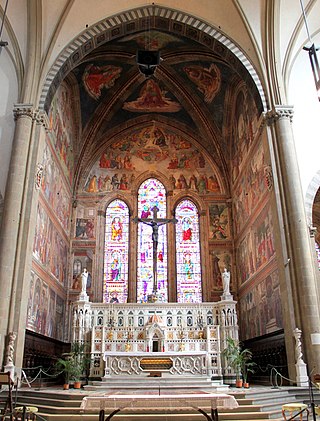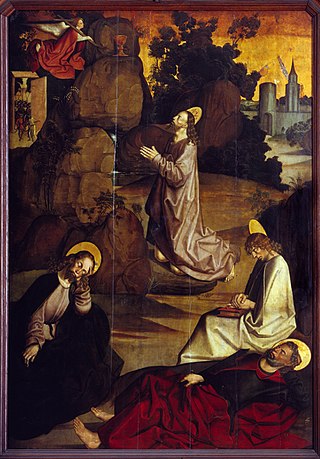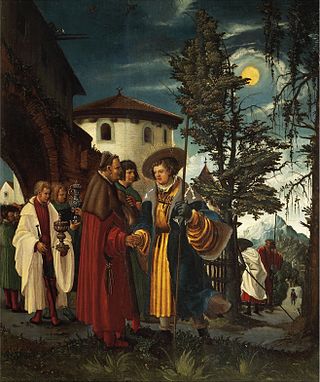
Albrecht Altdorfer was a German painter, engraver and architect of the Renaissance working in Regensburg, Bavaria. Along with Lucas Cranach the Elder and Wolf Huber he is regarded to be the main representative of the Danube School, setting biblical and historical subjects against landscape backgrounds of expressive colours. He is remarkable as one of the first artists to take an interest in landscape as an independent subject. As an artist also making small intricate engravings he is seen to belong to the Nuremberg Little Masters.

The Alte Pinakothek is an art museum located in the Kunstareal area in Munich, Germany. It is one of the oldest galleries in the world and houses a significant collection of Old Master paintings. The name Alte (Old) Pinakothek refers to the time period covered by the collection—from the fourteenth to the eighteenth century. The Neue Pinakothek, re-built in 1981, covers nineteenth-century art, and Pinakothek der Moderne, opened in 2002, exhibits modern art. All three galleries are part of the Bavarian State Painting Collections, an organization of the Free state of Bavaria.

The Virgin and Child with Saint Anne and Saint John the Baptist, sometimes called The Burlington House Cartoon, is a drawing by Leonardo da Vinci. The drawing is in charcoal and black and white chalk, on eight sheets of paper that are glued together. Because of its large size and format the drawing is presumed to be a cartoon for a painting. No painting by Leonardo exists that is based directly on this cartoon, although the drawing may have been in preparation for a now lost or unexecuted painting commissioned by Louis XII. The drawing is the only extant larger-scale drawing by the artist.

Caravaggio created one of his most admired altarpieces, The Entombment of Christ, in 1603–1604 for the second chapel on the right in Santa Maria in Vallicella, a church built for the Oratory of Saint Philip Neri. A copy of the painting is now in the chapel, and the original is in the Vatican Pinacoteca. The painting has been copied by artists as diverse as Rubens, Fragonard, Géricault and Cézanne.

The Tornabuoni Chapel is the main chapel in the church of Santa Maria Novella, Florence, Italy. It is famous for the extensive and well-preserved fresco cycle on its walls, one of the most complete in the city, which was created by Domenico Ghirlandaio and his workshop between 1485 and 1490.

The Master of the Morrison Triptych is the name given to an unknown Early Netherlandish painter active in Antwerp around 1500-1510. He is named for the Morrison Triptych, now in Toledo, Ohio, United States, which is described below.

Christ taking leave of his Mother is a subject in Christian art, most commonly found in Northern art of the 15th and 16th centuries. Christ says farewell to his mother Mary, often blessing her, before leaving for his final journey to Jerusalem, which he knows will lead to his Passion and death; indeed this scene marks the beginning of his Passion. In early versions just these two figures are usually shown, at half-length or less.

The Battle of Alexander at Issus is a 1529 oil painting by the German artist Albrecht Altdorfer, a pioneer of landscape art and a founding member of the Danube school. The painting portrays the 333 BC Battle of Issus, in which Alexander the Great secured a decisive victory over Darius III of Persia and gained crucial leverage in his campaign against the Persian Empire. The painting is widely regarded as Altdorfer's masterpiece, and is one of the most famous examples of the type of Renaissance landscape painting known as the world landscape, which here reaches an unprecedented grandeur.

The Hundred Guilder Print is an etching by Rembrandt. The etching's popular name derives from the large sum of money supposedly once paid for an example. It is also called Christ healing the sick, Christ with the Sick around Him, Receiving Little Children, or Christ preaching, since the print depicts multiple events from Matthew 19 in the New Testament, including Christ healing the sick, debating with scholars and calling on children to come to him. The rich young man mentioned in the chapter is leaving through the gateway on the right.

The Swoon of the Virgin, in Italian Lo Spasimo della Vergine, or Fainting Virgin Mary was an idea developed in the late Middle Ages, that the Virgin Mary had fainted during the Passion of Christ, most often placed while she watched the Crucifixion of Jesus. It was based on mentions in later texts of the apocryphal gospel the Acta Pilati, which describe Mary swooning. It was popular in later medieval art and theological literature, but as it was not mentioned in the Canonical Gospels, it became controversial - Protestants rejecting it outright, and from the 16th century discouraged also by many senior Catholic churchmen.
John Fuller Russell (1813–1884), was a priest in the Church of England, a writer, mostly on theological subjects, especially religious ritual, and a notable art collector. He was a member of the committee of the Ecclesiological Society and had close connections to the High Church Oxford Movement.

The world landscape, a translation of the German Weltlandschaft, is a type of composition in Western painting showing an imaginary panoramic landscape seen from an elevated viewpoint that includes mountains and lowlands, water, and buildings. The subject of each painting is usually a Biblical or historical narrative, but the figures comprising this narrative element are dwarfed by their surroundings.

The Rest on the Flight into Egypt is a subject in Christian art showing Mary, Joseph, and the infant Jesus resting during their flight into Egypt. The Holy Family is normally shown in a landscape.

Corisca and the Satyr was painted in the 1630s by the Italian artist Artemisia Gentileschi. It currently hangs in a private collection.

Pietà or The Dead Christ Supported by the Virgin Mary and St John the Evangelist is a c. 1465–1470 tempera-on-panel painting by the Italian Renaissance artist Giovanni Bellini, now in the Pinacoteca di Brera in Milan.

The Litoměřice Altarpiece (1505–1507) was a large altar retable, in all likelihood with two pairs of movable wings and two pairs of fixed ones. From these wings, six panels have survived, two of which are painted on both sides. The movable wings on the left-hand side of the altar are presumed lost. The altar wing depicting Christ on the Mount of Olives belongs to the Diocese of Litoměřice, while the other panels are owned by the Regional Museum in Litoměřice. It is the largest surviving set of panel paintings by an anonymous late Gothic and early Renaissance painter called the Master of the Litoměřice Altarpiece. The altarpiece is part of the permanent collection of the North Bohemian Gallery of Fine Art in Litoměřice.

Christ Taking Leave of his Mother is a 1595 oil on canvas painting by a Greek artist Theotokopoulos Domenikos, better known as El Greco. The painting represents the first depiction of the subject by the artist.

The Ark of Doudleby (1494) is a set of three double-sided painted panels that were part of a winged altar, the centre of which was probably a cabinet with a statue of Pieta. This incompletely preserved altar is the finest set of late Gothic paintings in the collection of the Aleš South Bohemian Gallery in Hluboká nad Vltavou.

Saint Florian Taking Leave of the Monastery is an oil-on-panel painting by German artist Albrecht Altdorfer, dating from around 1518–1520. It is held in the Uffizi Gallery, in Florence.


















